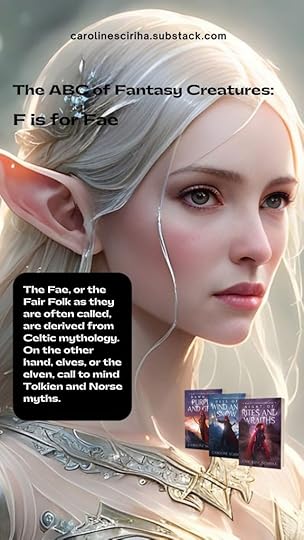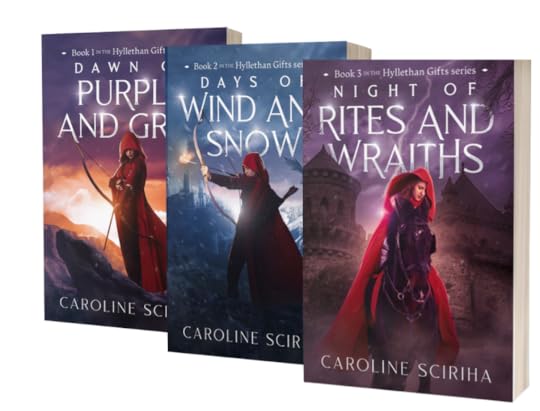F is for Fae; and my writing process
Recently, a friend asked me about my writing process and I thought this topic could interest others too.
I describe it as the messy process of tricking my brain to write!
In my day job as a teacher and Head of Department of English, I am organised and plan my work rigorously and well ahead, but when it comes to writing, I’m messy, impulsive, and insecure. However, after writing eight books, three of which will never see the light of day, I’ve learnt to embrace this as part of the process which leads, hopefully, to something worth publishing.
Writing is hard. That’s a truism which I wholly agree with but not because of a fear of the blank page. In my case, it’s more because I need to trick my mind into sitting down to type words which I know others would one day read. That is scary, for me. My ‘trick’ is to tell myself that it’s only a 0-draft, a draft which is only there to get words on paper and organise my several plot and character ideas into some cohesive whole—nothing in other words which cannot and will not be edited. It works for me. While I always start with a plan before writing the 0-draft, as soon as I do begin drafting, the characters kick that plan out of the window and decide, as teenagers tend to do, that their way is much better. They’re usually right.
I tend to write leanly, so 0-drafts end up being around forty-thousand words long, half what the novel ends up being. This is great as it gives me loads of space to add flesh to the ‘skeleton’ and if I have to throw away scenes and drastically modify the plot during revision, deleting a thousand words or so doesn’t hurt as much as throwing away thousands of words. (Actually I don’t delete, just paste it on another document and save it in a ‘deleted bits’ folder. Sometimes I scramble through those deleted bits to find just what I suddenly need and am so thankful it’s already written  ).
).
My novels braid magic, mystery and romance, but while going through the 0-draft to produce the next draft there’s always a point where I think the plot is not working well, that it’s bland, predictable, boring (pick your adjective; they all fit  ). That’s when I stop and re-assess. My strategies? I use various, such as:
). That’s when I stop and re-assess. My strategies? I use various, such as:
• re-read what I’d written before, hoping something pops where the plot seems to drag;
• do a free writing session where I get the main protagonist/s to give vent about the situation and their feelings for a love-interest, or about an antagonist. This tends to result in layers of thought, emotions and backstory ideas I hadn’t considered before.
• look at the plot from the point of view of a different character—primarily the antagonistic character and/or a minor character who has some undeveloped conflict in the plot. This strategy works each time. These pov inversions tend to reveal a rich treasure trove of material, such as backstory motivation, and very often twists which takes the plot and resolution down a different path, or even have at times resulted in a different, hidden, antagonistic character gaining prominence. And it works great on the level of plot: I hadn’t seen it coming, so it takes readers by surprise, too. Of course, it often requires some slight changes to foreshadow the plot twist, but if the building blocks were there (and they would be for my brain to have targeted that character) then the twist results in that so rewarding ‘wow, I hadn’t seen that coming!’
Ideas for plots and plot twists come from everywhere, usually when I cannot get to my computer. I’ve learnt the hard way not to trust my brain to remember something even if it seems so vivid at that moment. I keep paper by my bedside. I scribble the idea even in the dark, hoping I’m not writing over another idea, or a change of wording I’d thought of when I’m about to fall asleep. It’s (not) ‘fun’ in the morning trying to decipher what I’d have written. Daylight ideas are easier. We all carry mobile phones nowadays. I’ve emailed ideas to myself, and even recorded my thoughts—except those tend to be the more difficult to understand in playback.
Once I have a fairly decent draft, the editing process begins. I find that breaking up the manuscript into four chunks (roughly equivalent to 4 Acts in plot-terms) makes it easier for me. I’d much rather sit down to edit 80-page chunks than know I have around 320 pages to go through. Again, my brain thanks me for that ‘trick’.
It’s a relief to finally reach the stage when I am ‘happy’ enough with the work to send it to my critique partners. The feedback makes me ‘less happy’ but I’m so thankful for their honest, and sometimes brutal, assessment. My work is that much better as a result. After I make modifications based on their feedback, my next step is to trick my brain into thinking that I’m reading something ‘new’ – very difficult after having read and reread the draft several times. I’ve found two methods that work for me, apart from putting the manuscript aside for a few days, or better weeks: Firstly, I convert the doc to epub and upload it on my e-reader. I’m always shocked by how different it seems and how many corrections to the wording I end up doing during this stage. Another editing pass involves looking for filler words and ‘favourite’ repetitive words through the ‘Find’ option. This is a tedious but necessary process that eliminates so many unnecessary words. I’ve made a list of these words which helps me each time I am close to finishing off a novel. Currently, the list stands at 29 words, starting with –ly, very, saw, thought…
One of my final passes involves using the Microsoft Read Aloud option. This enables me to catch words I’ve repeated close to one another, whether the sentence/s are too long and convoluted, whether the words have the right cadence, whether the pace reflects the action…
The final pass (??) involves reloading the latest version back on the e-reader. If I can read chunks without the need to change (several) words, make character motivation clearer, strengthen setting etc, then it’s done!
Phew! This is turning into a long post, so now let’s talk about Fantasy Creatures…
F is for Fae

In my last post, I wrote about the elves; today’s letter leads to a similar type of fantasy character: Fae.
The Fae, or the Fair Folk as they are often called, are derived from Celtic mythology. On the other hand, elves, or the elven, call to mind Tolkien and Norse myths.
It seems to me that nowadays, stories tend to blur any differences that the two terms might have had in the past. But to me, though elves and fae are related concepts in that the beings are often depicted as having similar physical and supernatural characteristics, I consider fae as bordering more on the self-centred, the thoughtlessly cruel, the superficial or capricious. Do you agree?
Some self-promo!

In the Inner Lands, there are three ways sixteen-year-old Shael can get herself and her family killed—by looking like the enemy; by working with the enemy; by becoming the enemy.
When sixteen-year-old Shael unknowingly helps a mortally wounded thief, he entrusts her with delivering three figurines to the lord of her castle. Too late, Shael discovers that the figurines were stolen from the Hyllethans, her country’s feared enemies. And since she cut her fingers on the figurines while handling them, she is now linked to them. Any breakage or pressure on the clay is felt on her flesh.
Despite her reluctance to aid the enemy, Shael teams up with three Hyllethans to retrieve the figurines and break the connection. Shael is caught in the tussle for the thrones of the two lands. To avoid becoming a pawn—or dangle from a hangman’s noose—she has to regain possession of the figurines and face the unsuspected secrets of her lost past.
Three thrones. Two power-hungry mages. One girl standing in their way.
Exiled in Hylletha, sixteen-year-old Shael longs to return to the land of her birth but her brother Iysel, the new, terrifying mage-king of the Inner Lands, wants her dead. Shael’s very existence threatens Iysel’s right to the throne since she is the holder of the magical Gift of Touch, which is traditionally held by the monarch.
To ensure peace, Theis, the young man Shael loves, goes to Iysel’s court to negotiate the reunification of Hylletha and the Inner Lands under one ruler. But when Shael’s young foster brother is abducted and held prisoner in the Inner Lands, Shael has only her limited knowledge of spellcraft to help her stay out of Iysel’s reach, rescue her foster brother and make sure Theis doesn’t bear the brunt of Iysel’s rage.
Complicating matters further, Iysel has won the unexpected support of their wily cousin—the son of the king of a neighbouring land and an extraordinary mage—who has his own reasons for wanting to get hold of Shael.
The stability of the three realms lies in the balance. Faced by intrigue and betrayal from all sides, Shael must choose between protecting the lives of those she loves or taking up her role as princess and heir to the thrones to safeguard the welfare of the people.
She’ll be crowned queen—if she lives that long.
With her coronation fast approaching, Shael fears the debilitating effects of poisoning resulting from her stint in the dragons’ birthing grounds will make her unfit to rule. But this becomes the least of her worries when her brother Iysel turns up claiming he’s the true King of Hylletha as well as heir to Dragonia. Shael is determined to protect the realms from the merciless mage, but the documents that challenge Iysel’s right to the thrones have disappeared.
Protecting the realms isn’t the only reason for finding the missing documents. Proving Iysel’s duplicity is the surest way of saving Theis, the love of Shael’s live, whom Iysel has accused of desertion and treason.
With time running out, with assassins stalking her every move and her health failing, Shael sets out to unravel the tangled web of deceit and greed ensnaring her and the kingdoms. Unfortunately, the most obvious culprit isn’t always the only enemy.
Dawn of Purple and Grey, Days of Wind and Snow, and Night of Rites and Wraiths (The Hyllethan Gifts Trilogy) are available through Amazon either as individual books or as a Complete Series Box Set.
Till next time,
Caroline



